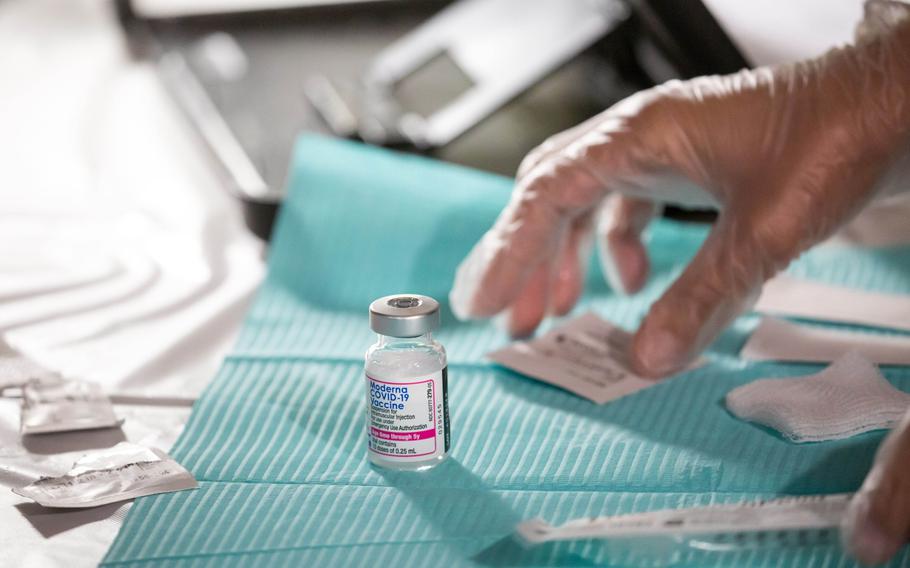
A healthcare worker prepares a dose of the Moderna coronavirus vaccine at the Brooklyn Children’s Museum vaccination site, serving children six months to 5 years old. (Michael Nagle/Bloomberg)
Stars and Stripes is making stories on the coronavirus pandemic available free of charge. See more stories here. Sign up for our daily coronavirus newsletter here. Please support our journalism with a subscription.
Nearly every U.S. state is battling high levels of flu-like illness, public health authorities warned Monday as multiple respiratory viruses threaten to overwhelm the health-care system while people travel for the holidays and gather indoors with friends and family.
Centers for Disease Control and Prevention officials say they're seeing signs of an early and severe flu season that turned significantly worse during Thanksgiving week, the official start of the holiday season.
That ferocious return of influenza is coinciding with the start of a third pandemic winter — with a novel coronavirus that never left.
"It's a perfect storm for a terrible holiday season," said the chair of the American Medical Association board, Sandra Fryhofer, an Atlanta infectious-diseases physician who joined a Monday briefing by the CDC.
Levels of flu-like illness, a measure of medical visits with respiratory symptoms that could also be caused by RSV or the coronavirus, were high or very high in 47 jurisdictions during Thanksgiving week, up from 36 the previous week, said CDC Director Rochelle Walensky. Hospitals admitted nearly 20,000 influenza patients, almost double the number from the previous week. Officials also reported two new pediatric flu fatalities, bringing this season's death toll in children to 14.
In all, the CDC has recorded at least 8.7 million illnesses, 78,000 hospitalizations and 4,500 deaths from flu since October.
Meanwhile, coronavirus hospitalizations are also rising, while cases of respiratory syncytial virus, commonly known as RSV, remain high, although they appear to have peaked in some regions.
"The past several years have certainly not been easy, and now we face another surge of illness, another moment of overstretched capacity, and one of tragic and often preventable sadness," Walensky said at the briefing.
Walensky urged Americans to get their flu shots and updated coronavirus vaccine boosters, which are tailored to omicron subvariants. She said that early data suggests this year's flu shot formula appears to be well matched against the circulating strains, and that shots drive down hospitalizations even when they do not stop infections.
Public health authorities have been worried about flu vaccination rates that have been lower than in previous years, including in groups at high risk of hospitalization, including young children, pregnant people, and adults 65 and older.
"We all have booster fatigue, but understand you could get really, really sick this year and ruin your holiday celebrations if you don't get vaccinated," Fryhofer added of the new coronavirus booster shots.
Officials also offered some good news about RSV, which has no authorized vaccine yet.
Surges of that virus appear to have peaked in the South and Southeast and may be leveling off in the Mid-Atlantic, New England and the Midwest, Walensky said.
"While this is encouraging, respiratory viruses continue to spread at high levels nationwide, and even in areas where RSV may be decreasing, our hospital systems continue to be stretched with high numbers of patients with other respiratory illnesses," she added.
Walensky urged those with symptoms of flu or COVID-19 to see doctors early to get prescription antivirals that greatly reduce the likelihood of severe illness if taken within the first days of illness.
Health officials have also prioritized administering flu and coronavirus vaccines to reduce the strain on hospitals, at a time when no major jurisdiction has imposed a mask mandate to limit transmission.
On Monday, Walensky said that the CDC recommends masking on public transportation and that "we also encourage you to wear a high-quality, well-fitting mask to help prevent the spread of respiratory illness, especially for the 5 percent of the population currently living in counties with high COVID-19 community levels."
The CDC is not a regulatory agency, so it can recommend masking but not mandate it.
The agency adopted a new system early this year to link masking recommendations to a formula that emphasized the strain on hospitals rather than just the number of infections. That formula is being tested as hospitals fill up with people infected by other respiratory viruses, meaning new coronavirus infections can threaten hospital capacity even at lower volumes.
Walensky said the CDC was re-examining its metrics but noted that Americans who are concerned about the triple viral threat can act to protect themselves immediately.
"One need not wait for CDC action in order to put a mask on," she said.